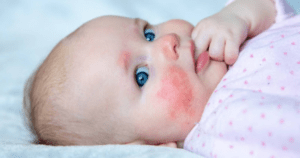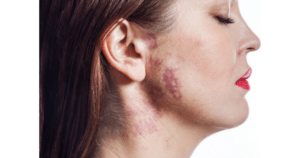Common Pediatric Dermatology Concerns
Newborn Rashes
Newborns are prone to many types of skin rashes, which may be alarming to parents. Although most rashes are harmless, several other rashes can indicate severe infections and constitute emergencies. Rashes associated with life threatening situations include bacterial sepsis, meningitis, herpes and autoimmune diseases like Kawasaki’s syndrome. As a parent, it is important to be aware of the potential severity of such rashes and the vulnerability of newborns and understand that expert opinion and immediate care are paramount.
At Anne Arundel Dermatology, we can help diagnose, treat, and provide advice on managing newborn rashes. We are here to answer any questions and provide the best care possible for your little one. With our knowledgeable and experienced providers, you can rest assured your newborn is in good hands.
Type Of Rashes
Newborn rashes can be caused by a variety of factors, including irritation from contact with a new environment, allergies, or infections
Common types of rashes seen in newborns include:
Heat Rash
Heat rash, also known as miliaria, is a common skin condition that occurs in newborns. It is caused by sweat glands becoming blocked and trapped beneath the skin, leading to a rash of red bumps. The rash typically appears on the neck, chest, and diaper area and can be itchy and uncomfortable for the baby.
Treating a heat rash in newborns typically involves keeping the affected area cool and dry and avoiding excessive sweating. Your doctor may also recommend using a mild, fragrance-free moisturizer to soothe the skin. In most cases, a heat rash will resolve on its own within a few days, but it’s crucial to contact a healthcare provider if the rash persists or your baby develops a fever.
Diaper Rash
To treat diaper rash, keep the diaper area clean and dry, and use a diaper rash cream or ointment. You can also give your baby a warm bath to help soothe the skin. However, if the rash does not improve or is severe, it is important to contact a healthcare provider for further treatment.
Diaper rash is a common condition that affects newborns and infants. It is a red, inflamed rash that appears on the skin in the diaper area. It is typically caused by irritation from urine and feces and can also be caused by yeast or bacterial infections.
Erythema Toxicum
Erythema Toxicum is a common rash that affects newborns. It appears as red or yellow bumps on the baby’s skin, often accompanied by small white or yellow spots in the center. The rash typically occurs within the first few days of life and may last several weeks. It is generally harmless and does not require treatment, but it can be uncomfortable for the baby.
If the rash is causing discomfort, your doctor may recommend using a mild, unscented moisturizer to keep the skin hydrated and soothe irritation. In most cases, the rash will resolve on its own within a few weeks.
Baby Eczema
Eczema, also known as atopic dermatitis, is a common skin condition that affects newborns and infants. It is characterized by dry, red, and itchy skin and can appear on the face, scalp, or other parts of the body. While the exact cause of eczema is unknown, it is thought to be related to an overactive immune system and a deficiency in the skin’s ability to retain moisture.
Treatment for eczema in newborns typically involves using moisturizers to hydrate the skin and reduce itching, as well as corticosteroid creams to reduce inflammation. In severe cases, other medications, such as immunosuppressants, may be used. It is important to avoid exposing the baby to potential irritants and allergens and to keep the skin clean and moisturized to prevent flare-ups.
Find a Solution to Your Newborn’s Rashes
At Anne Arundel Dermatology, our team of highly trained and experienced pediatric dermatologists can provide the care your newborn needs for rashes. We will work to determine the underlying cause of the rash and provide the most effective treatment plan for your baby’s unique situation. From diagnosis to treatment, our team is here to help you and your newborn find a solution. Request an appointment below.

Birthmarks
Birthmarks are common forms of changes in color or structure of the skin. Birthmarks can be present at birth or develop within the first few weeks of life. Most birthmarks are benign, meaning they are not cancerous. Birthmarks can appear anywhere on the body, including the face.
Most birthmarks are harmless and will fade away on their own without treatment. Many may indicate the presence of another condition and alert us to careful monitoring of our patients, serving as markers or warning signs of systemic diseases. Others, especially vascular lesions, cause significant cosmetic concerns as the child grows older. Most important is the correct interpretation of “birthmarks” by an experienced dermatologist who can place them in the right context. The appropriate interpretation precedes any treatment or removal. Various treatment options are available if your child needs to have a birthmark removed for any reason.
Understanding the Various Types of Birthmarks
Birthmarks stem from different causes and fall into various classifications.
Pigmented birthmarks develop when your child has too many pigment cells in a specific area. Pigment is what provides color to the skin. Pigmented birthmarks can be gray, tan, brown, black, blue, or a combination of these colors. Here are the most common examples of pigmented birthmarks:
- Café au lait spots: These oval-shaped and pale brown birthmarks get their name from the French expression “coffee with milk.” Your child can be born with café au lait spots or they could develop later in life. Children with several of these spots could have a medical condition known as neurofibromatosis that requires medical monitoring.
- Moles: Most people have several moles, some of which are actually birthmarks. Moles are round and can appear anywhere on the body. A mole that changes shape, size, or color over the years may become cancerous and you will need to have a dermatologist biopsy it. Fortunately, skin cancer is rare in children.
- Blue spots: These flat spots are blue and gray in color and occur naturally in people with darker skin tones. They typically blend into the surrounding skin over time and are less visible.
Vascular birthmarks occur when blood vessels in a certain area of skin do not develop the way they should. There could be too many blood vessels in one area, or the blood vessels could be wider than usual and leave a mark on the skin. Approximately 5-10 percent of newborns have one of these types of vascular birthmarks:
Hemangiomas: These birthmarks typically appear on the head, neck, or extremities and are blue, pink, or bright red in color. Most disappear by adolescence. They are more common in premature, girls or twin pregnancies.
Innocent Capillary Malformations, Port-wine stains and Salmon Patches, Stork bites: Also called nevus flammeus, port-wine stain birthmarks develop due to abnormal formation of small blood vessels (capillaries) underneath the baby’s skin. They typically start out pink or light red and later become dark purple or dark red. Unlike other types of birthmarks, port-wine stains usually do not fade over time and may become darker instead. The skin surrounding these birthmarks becomes extremely dry and thick as well.
Most common locations are between the eyebrows/eyes, or the back of the neck. Clustering of small blood vessels under the skin causes salmon patches, and they typically fade away within several months.
Complex Vascular Malformations with enlarged arteries, veins, and capillaries: Those can be very disfiguring and grow over time with major disfigurement and causing significant disfigurement by affecting whole extremities.

Our providers at Anne Arundel Dermatology can advise you on the best treatment option for birthmark removal, including laser treatments, steroid injections, or surgery. Please contact us to request your initial consultation. Remember that a simple “birthmark” can be an indication of a major internal disease. Not all birthmarks are created equal.
Eczema
Eczema is a common skin condition that also goes by the names atopic eczema, dermatitis, and atopic dermatitis. The condition, which is especially common in children, causes red patches to appear on the skin that are scaly, itchy, and dry.
Who Gets Eczema, and How Long Does It Last?
This skin condition frequently appears in children during their first year of life. The itching caused by eczema can be so intense that some babies and toddlers may not be able to sleep. Since they do not fully understand how to scratch itchy skin to make it feel better, very young children may rub their skin against the nearest surface in an attempt to find relief. Eczema is not contagious.
Skin rashes can make children feel uncomfortable and may require treatment to avoid secondary infection. Parents can also take steps at home to reduce the likelihood of an eczema flare in their child. For example, babies and toddlers with eczema are often sensitive to the dyes used in soaps and laundry detergents. Parents should choose products without these added ingredients. They also need to moisturize their child’s skin regularly.
Some people who develop eczema during childhood continue to deal with the uncomfortable symptoms into their adulthood. They may go several years between flare-ups. Although it is less common, some people never develop eczema during childhood and do not notice their first symptoms until they are adults.
What Causes Eczema?
One of the essential roles of healthy skin is to retain moisture that protects the body from allergens, bacteria, and irritants. People with eczema appear to have variations in their genes that prevent the skin from performing this function effectively. Children who already have food allergies are more prone to developing eczema. Other risk factors include having a family history of eczema, seasonal allergies, asthma, or hay fever.
Common Symptoms of Eczema
Keep in mind that the symptoms of eczema can vary significantly between children and adults and from one person to the next. Here are some typical indications that you or your child might have eczema:
- Cracked, dry, thickened, or scaly skin
- Patches of skin that are brownish-gray or red in color that appear on the upper chest, hands, wrists, neck, feet, ankles, eyelids, and inside the bend of the knees and elbows. Children may also have eczema patches on their cheeks or scalp.
- Raised bumps that can crust over when scratched and leak clear fluid.
- Severe itching.
- Skin that appears swollen, thickened or raw due to intense and chronic scratching.
You or your child may have developed a secondary skin infection if you notice oozing pus, yellow scabs, or red streaks on the skin. Please seek treatment from Anne Arundel Dermatology immediately in this situation to prevent the infection from spreading or getting worse. We recommend a combination of home remedies and professional dermatology treatment for eczema to ensure healthy skin for a lifetime. Left untreated, eczema can cause significant problems with sleep and quality of life.
Please contact our dermatology providers today to learn more about safe and non-invasive treatment options for eczema.
Cradle Cap
Cradle Cap (seborrheic dermatitis) is a harmless condition common in infants. Red, scaly patches can develop on the skin of the baby’s scalp and will usually disappear within several weeks. Cradle cap is not contagious and fortunately, it does not create discomfort for the baby. This skin condition is not due to poor hygiene or allergies and will not leave scars.
Hemangioma
An infantile hemangioma birthmark is a red nodule of extra blood vessels in the skin, (most infant hemangiomas are capillary hemangiomas). This type of birthmark usually grows during the child’s first year, and slowly recedes over time. By age ten there is almost no evidence the hemangioma’s existence.
A hemangioma can occur anywhere on the body, but most commonly appears on the face, scalp, chest or back. Treatment of a hemangioma usually isn’t needed, unless the nodule interferes with vision or breathing.
Atopic Dermatitis
Atopic dermatitis, or eczema, is a skin condition that often starts in early childhood (although people of all ages can be affected). Over 50% of infants with atopic dermatitis grow out of the condition by age two. While atopic dermatitis is a chronic condition that does not have a cure, our board-certified dermatologists can diagnose, control and provide solutions to treat this concern.
Atopic dermatitis can get worse when the skin comes into contact with irritating substances such as harsh soaps and scratchy, tight-fitting clothing. Friction can also be a contributing factor, especially when affected children start to crawl.
Other Concerns
- Eczema
- Warts
- Head Lice
- Hives
- Poison Ivy
- Impetigo
- Rashes
- Sunburns
- Complex skin conditions
Schedule an Appointment
At Southern Dermatology, we are trained to place the well-being and safety of our patients above all else. Our doctors combine a deep understanding of dermatology with advanced medical aesthetics to help minimize the signs of aging. Schedule a visit for any skin condition. Your best skin awaits!


